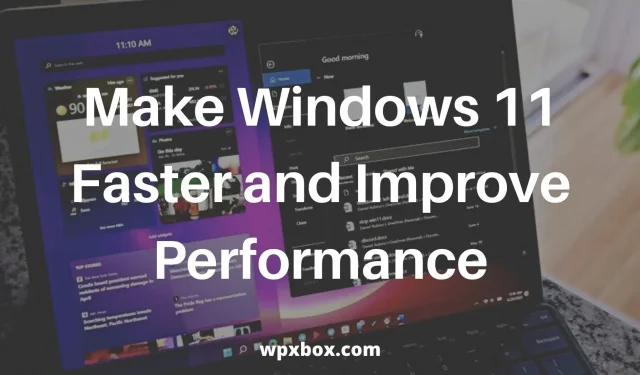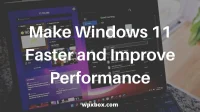Unlike previous generation versions of Windows, Windows 11 contains many performance improvements. Now it has become faster, better and more elegant. However, those who have upgraded from Windows 10 and are still using older hardware may still experience issues. Luckily, there are a few tweaks that can speed up Windows 11, which I’ll cover below.
Make Windows 11 faster and more productive
Try some of these tips if your PC or laptop is lagging behind in performance.
- Restart/refresh
- Disable visual effects
- Switch to performance plan
- Disable autoloading apps
- Enable Memory Sense
- Delete temporary files
- Turn off notifications
- Remove Bloat and Unwanted Apps
- Defragment your hard drive
- RAM/SSD upgrade
- Disable restartable apps
- Disable VBS
Some of these tips are extreme. You should only do this if you have a problem with the product you are using and it is interfering. However, never compromise on security.
1. Restart and update
One of the first things you should do is see if there are updates available. Updates also often improve system performance, help get rid of bugs, and offer new features. To check for updates, go to Settings > Windows Update > Check for Updates. If any update is available, install it and see if it works.
Also, if your computer is already up to date and you have been facing a slow computer for a while, consider restarting your computer.
2. Turn off visual effects
By default, Windows 11 uses animation effects for elements and controls. However, this may affect the overall performance of your computer. Therefore, it is recommended to disable visual effects. To do this, follow these steps:
- Go to the Windows 11 search box and type “Advanced”.
- Launch View advanced system settings from the search results.
- Click the Advanced tab if it’s not already selected.
- Click Settings.
- In the next window, select Adjust for best performance.
- Then below select Custom and select Show thumbnails instead of icons and Smooth edges of screen fonts .
- Finally, click Apple > OK.
3. Switch to a performance plan
A power plan is a combination of hardware and system settings to manage your device’s power consumption.
By default, it is set to balanced mode. But if you don’t want to care about battery life and enjoy maximum performance, then you’d better switch to high performance mode by following these steps:
- Go to Windows search, type power plan and run “Edit Power Plan”.
- Click “Choose a power plan”.
- In the next window, select the High-Performance plan. Also, if you are into gaming, you can choose the Power Boosted Power Plan.
- In case you can’t find high performance mode. Then follow these steps:
- Click Change plan settings > Change advanced power settings.
- Then click “Processor Power Management”and make sure the minimum and maximum processor state is 100%.
4. Disable autoloading apps
By disabling starter apps, you can speed up Windows 11 and get better performance. To disable auto-loading of applications, follow these steps:
- Go to Windows Start Menu > Settings.
- In the sidebar, select Applications > Startup.
- It will now display all apps enabled to run on startup.
- Disable apps that have a big impact and you don’t use them.
5. Turn on Memory Sense
In Windows 10 and 11, we see the Storage Sense feature that automatically frees up storage space for you. It frees up memory by deleting files you don’t need, like temporary ones. Thus, you can enable this feature to automatically free up space on your computer and improve the overall performance of your system.
To enable it, follow these steps:
- Go to Settings with Win + I
- Go to System > Storage.
- Click Storage Sense.
- Then experiment with the settings to schedule your cleanup.
- Or you can click on the “Start memory monitor now”button at the end.
6. Delete temporary files
Over time, a lot of temporary files accumulate on your computer. For example, cache, downloads, thumbnails, update logs, optimization files, temporary internet files, and more.
These temporary files can greatly affect the performance of your PC. Therefore, it is recommended to clean up temporary files from time to time.
To clear it, you can follow these steps:
- Go to Settings > System > Storage.
- Click Temporary Files.
- Here, select the files you don’t need and click the “Delete”button located at the top.
7. Turn off notifications or reduce them
If you receive constant notifications on your computer from email, browser notifications, etc., they use a lot of system resources, slowing down your PC. But you can quickly turn off notifications by doing the following:
- Go to Settings with Win + I
- Go to System > Notifications.
- Now at the top you will see the “Notification”option. Click on it to disable all notifications.
- If you want to turn off notifications for certain apps, scroll down and select the apps for which notifications should be turned off.
8. Remove bloated and unnecessary apps from Windows 11.
You can also offload your Windows 11 system to improve overall performance. This includes disabling unnecessary system apps that you don’t even use such as OneDrive, mail app, Cortona, etc.
To unlock Windows 11, you can follow these steps:
- Press the Windows key + X and launch Windows Terminal (Admin).
- Then copy and paste the following command into the Windows Terminal.
iwr -useb https://git.io/debloat|iex
(Wait while your computer creates a restore point).
- After that, you will see a window offering you inflate options. Enable or disable apps you don’t need.
That’s all. You have successfully uninstalled most of the pre-installed applications on your Windows computer.
9. Defrag HDD (not for SSD)
Since you have been using your computer for a certain period of time, your hard drive may be the reason behind the poor performance. You can defrag your hard drive with a defrag tool to fix this problem.
However, please note that if you are using an SSD, then running a defragmenter is not recommended as this will shorten the life of your SSD.
But if you have a hard drive, follow these steps:
- Go to Windows search, type Defrag, Optimize Drives and run it.
- After that, select the drive you want to defragment.
- Finally, click the optimize button to continue.
10. Upgrade RAM/SSD
You can also increase your computer’s RAM to improve your computer’s performance and make it faster. Modern OSes have begun to consume more memory, and if your computer is outdated or does not meet the minimum hardware requirements, it is best to upgrade.
Similarly, you can also switch to an SSD. An SSD offers improved performance and faster boot times. Because SSDs are expensive, you can opt for a 256GB SSD and migrate Windows. The rest can remain on the HDD.
11. Disable restartable apps
You can also disable restartable apps to make your Windows 11 system faster and smoother. Because Windows 11 restarts some background applications that can slow down your computer. So, to disable such applications, follow these steps:
- Go to “Settings”and go to “Accounts”> “Login Options”.
- Here, disable the “Automatically save my restartable apps and restart them when I sign in again”option and you’re done.
12. Disable VBS
Note. Do this only in a specific case or when you need to test your code.
Virtualization Based Security or VBS is a new feature in Windows 11. It protects the operating system from unsafe code and malware. This is part of the HVCI level. But if the function is enabled, then the overall performance of your PC drops by 5-25%. So, to disable this feature, follow these steps:
- Go to Windows search, search for Core Isolation and run it.
- Then turn off the memory integrity feature.
13. Disable game mode
If you are not into gaming, it is recommended to turn off Game Mode. This will stop DVR and other Xbox related services from running in the background. As a result, you will get better performance. To disable it:
- Go to “Settings”and go to “Games”.
- Go to game mode and turn it off.
So these were some of the best ways to improve the overall performance of Windows 11 and make it faster. Now try applying these hacks on your Windows PC and see if it worked for you. Also, for any further questions, leave a comment below.


